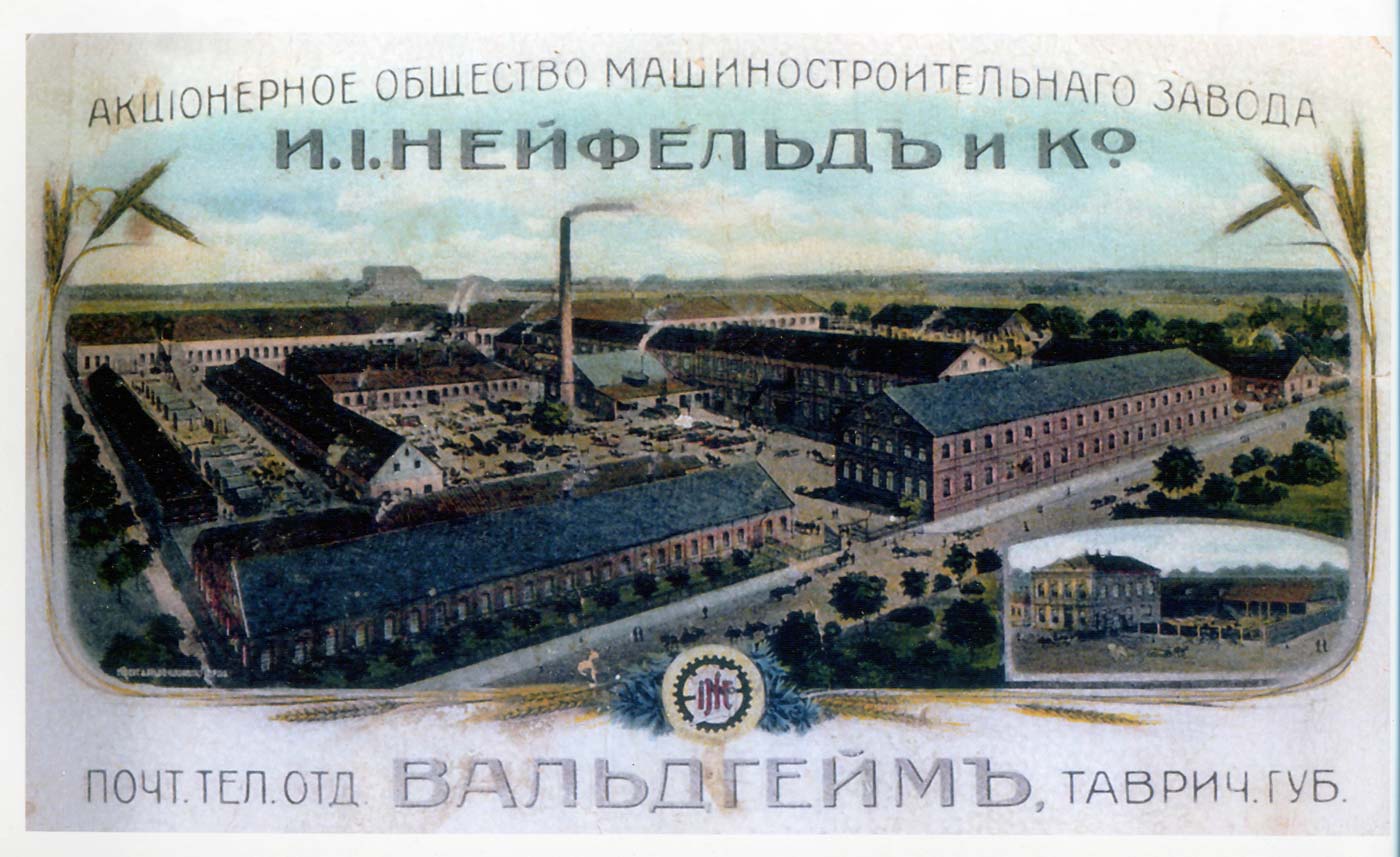If you recall several posts from early 2015 (see here and here), the Waldheim school records from 1861–1862 leave little doubt but that David and family were residents of Waldheim by that time, as David’s sons Benjamin and David appear on the school register. The school records for 1873–1874 add another piece to the puzzle, as they list not only a younger son who is now in school (Jacob) but also indicate that David was the owner of Wirtschaft (farm) 48.
 |
| Over time Waldheim grew to become the largest village in Molotschna colony. By the early 1900s Waldheim was home to significant industry, including a factory for manufacturing farm implements. |
This village was founded in 1836. That year eight landowners settled in it, twelve in the year 1838, and twenty landowners in 1840. …
The sixty-eight families of this village came from the province of Volhynia.
The sixty-eight families of this village came from the province of Volhynia.
The first quotation states that Waldheim was founded in 1836 and that three groups of landowning families took up residence within it over the next five years. The second reports the state of affairs in 1848, when the community record was written. At that time sixty-eight families were associated with the new village. One might deduce from this that, between the years 1840 and 1848, twenty-eight additional families had moved to Waldheim.
Although that is a plausible first reading, it is not necessarily the correct one. Here it is important to recognize what the first quotation both says and does not say. For the years 1836, 1838, and 1840, the community report is concerned only with landowners*: there were forty farmsteads in Waldheim (as in nearly all early Molotschna villages), and by 1840 all forty farmsteads had been claimed. That is all that the first quotation has to stay. It does not claim that no other families came to Waldheim during those years; in fact, it seems quite likely that other (landless) families settled in the village at least in 1840; more on that further below.
One thing we know for certain is that the sixty-eight families who lived in Waldheim in 1848 came from the province of Volhynia. The writers do not say that some came from Volhynia and that others came from other villages in Molotschna, nor do they say that the original forty landowning settlers came from Volhynia and that the other residents came from Molotschna. No, the community report states that all of the families in Waldheim in 1848 came from Volhynia.
Why is this important? It implies that the families who emigrated from Volhynia to Waldheim did so a little less “neatly” than one might imagine. It seems a bit too convenient that, after eight families emigrated in 1836 and another twelve did so in 1838, an even twenty—exactly the right number to fill out Waldheim’s forty available farmsteads!—emigrated in 1840. The impression one might have is that, remarkably, all of the families who emigrated in 1836–1840 ended up owning land in their new home.
In fact, it seems quite likely that more than twenty families emigrated from Volhynia to Waldheim in 1840: some of them became landowners, while others probably worked as artisans or farmhands for the fortunate forty. The report does not mention the “additional” families for 1840 because its interest in the first section is only with the landowners. Further, it is reasonable to think that families continued to emigrate from Volhynia to Waldheim even after 1840 so that eight years later, in 1848, the village numbered sixty-eight families originally from Volhynia.†
In light of all this, several questions naturally arise: When did David Buller first take up residence in Waldheim? When did Helena Zielke Buller come to live in Waldheim? Did David and Helena come to Waldheim together or separately? From where did they come either individually or together? The answers to these questions still await further explanation and, especially, evidence.
Other aspects of the report deserve attention as well, such as the places in Volhynia from which the Waldheim residents emigrated and the areas (Neumark and Schwetz) that the emigrants’ parents and grandparents had earlier called home. A subsequent post or two will explore those trails; for now it is enough to know that, as of 1848 (when David Buller was thirty-one), all the residents of Waldheim had emigrated there from Volhynia. If David was a resident of Waldheim at that time, he, too, had lived in Volhynia in the recent past.
Notes
* The German term Wirte is here translated “landowners.” Other possible renderings are “hosts” or “landlords.” The emphasis clearly is on ownership, so “landowners” seems an accurate, idiomatic translation.
† Margarete Woltner provides figures for 1855 and 1857 in a note (see the earlier post). In 1855 the village included 91 resident families, 51 of whom were landless; in 1857 Waldheim comprised 102 resident families, 59 of whom did not own land. Thus, in the seven years from 1848 to 1855, Waldheim increased by 23 families (33 percent, or 4.8 percent per year). In the two years from 1855 to 1857, the village increased by 11 families (12 percent, or 6.0 percent per year). This high rate of growth would seem to imply ongoing migration to Waldheim (whether from Volhynia, villages in Molotschna, or both), not merely natural population growth. Not to be forgotten is that some families in Waldheim went back to Volhynia in 1848. See the Global Anabaptist Mennonite Encyclopedia Online article on Volhynia here.
No comments:
Post a Comment